There are various body language movements that budgies make in response to the events around them or as a result of the physical and mental conditions they experience. Each gesture and movement can mean different things at different times.
If you know the body language of budgies, you can easily understand their needs and problems. In this way, you can provide them with a healthier and happier life.
Why Do Budgies Stand on One Leg?
Budgies tend to stand on one leg in different circumstances for different reasons. In addition, budgies can stand on one leg for a long time.
Unlike humans, budgies are usually in a more comfortable position when they stand on one leg, thanks to their leg and toe structure.
In addition, budgies may also want to stand on one leg for reasons such as sickness and fatigue. In these cases, they tend to do this movement for reasons such as energy conservation and rest.
The reasons why budgies stand on one leg can be listed as follows:
- Resting
- More comfort
- Sleeping
- Preserving heat
- Preserving energy
- Sickness
- Injury
- Fatigue
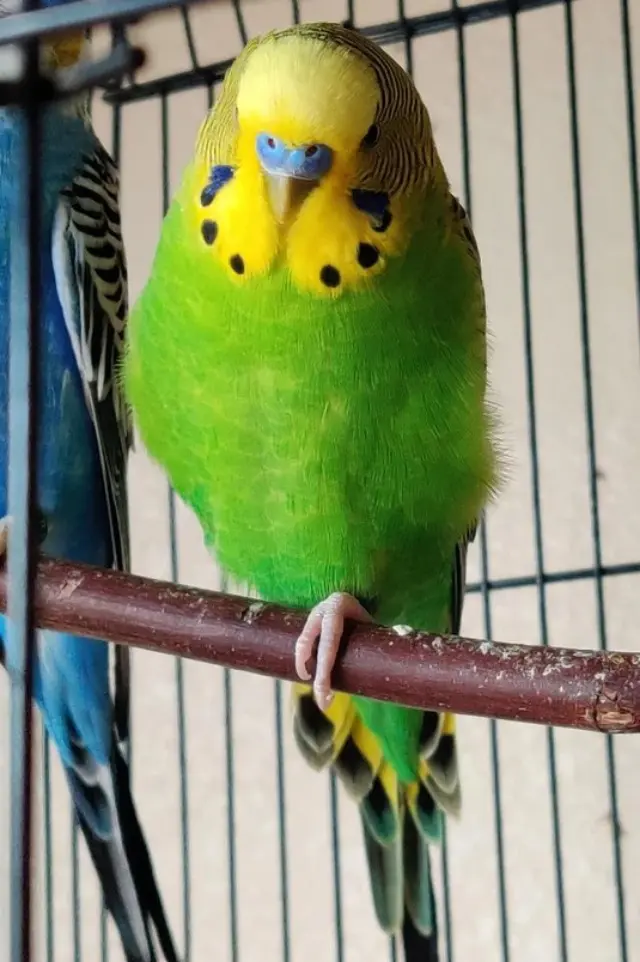
Why Does My Budgie Keep Flapping Its Wings While Not Moving?
The reasons why budgerigars flap their wings when they are not moving can be listed as follows:
- Exercise
- Providing and accelerating the blood circulation in the body
- Loss of the ability to fly as a result of their wings being clipped
- Trying to get attention and saying I am here
- Flapping wings as a dominance gesture
Why Does My Budgie Turn His Back on Me?
Budgies are birds that are frequently hunted by hunters, such as larger birds.
Therefore, they need to watch the side where the danger is coming from and the side where they can escape and hide.
In this case, they turn the front of their body in the direction of escape and their back to the side of the danger.
Finally, they turn their heads left or right. Thus, thanks to the eyes on both sides of their heads, they can easily check out both the back and the front.
When pet budgies are afraid, shy, annoyed, cautious, and want to escape easily from their owners, they turn their backs to their owners and the front side to the place where they’ll flee to escape more easily. Thus, they can quickly fly away in any situation.
Why Do Budgies Bob Their Heads Up and Down?
Head bobbing behavior is one of their most well-known body movements. Budgies bob their heads up and down for various reasons.
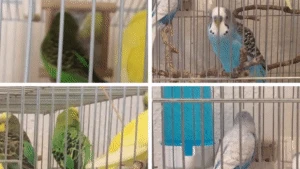
The reasons why budgies bob their heads can be listed as follows:
- Communication
- Trying to get attention
- Desire to mate
- Hunger
- Excitement
- Boredom
Why Do Budgies Twitch Their Wings?
Wing twitching can be seen in healthy budgies, besides it can also be seen in budgies that have a disease and suffer physically. Therefore, the cause of wing twitching should be well understood.
The reasons for a budgie’s wing twitch can be listed as follows:
- Physical pain
- Sickness
- Seizure
- Viral infection
- Muscle spasm
- Sprain
- Excitement
- The state of being on the alert to fly away
- Too much energy
- Getting ready for mating
Why Do Budgies Bite Each Other?
Biting is at the top of the body movements used by budgies in communication.
Budgies bite each other for reasons such as:
- Communication
- Showing dominance
- Territorial protection
- Protecting the food
- Expressing the desire to mate
- Anger
- Fright
- Dissatisfaction
- Harming the opposing side in a fight
- Self-protecting
Why is My Budgie Slightly Opening Its Wings?
The reasons why budgies keep their wings slightly open can be listed as follows:
- Excitement
- Happiness
- Seeking attention
- For faster evacuation of body heat in extremely hot weather and overheating conditions
- To warm their bodies faster in the morning
Why Do Budgies Pluck Their Feathers?
Budgies tend to pluck their wings for both physical and mental reasons. Therefore, you need to analyze why your budgie is plucking its feathers.
The reasons for feather plucking in budgies can be listed as follows:
- Anxiety
- Stress
- Loneliness
- Boredom
- Malnutrition
- Trying to get attention
- Sickness, allergies, infections
- Failure to mate
- Lack of exercise and activity
- Heat
- Humidity
Why is My Budgie Moving All the Time?
Budgies are extremely fast and active birds. A budgie with enough energy can be constantly on the move for a variety of reasons, such as boredom, exercising, hunger, hormonal reasons, the constant instinct of self-preservation, and attracting the attention of other birds and humans.
Why is My Budgie Always Nibbling?
The beaks of budgerigars are like human hands. They make gentle nibbles with their beaks to recognize, show affection, taste, explore, and interact with surrounding objects and creatures.
How Do You Know if a Bird Wants Attention?
Budgies are highly social creatures and live in flocks in their natural lives. They are in constant communication and interaction.
In addition, they can become stressed when there is not enough interaction and communication.
However, there are body movements that indicate they want the attention of other budgies or animals. Budgies screech, flap their wings fast, rub their body to others, follow, regurgitate, and bob their heads to attract attention.
Why Does My Budgie Shaking Its Wings and Leaning Forward?
Among the reasons why budgies shake their wings and lean forward, there are reasons such as preparing to fly, extreme fear due to suddenly appearing predators, and showing to male budgies that they are ready to mate in females.
Why Does My Budgie Close His Eyes When I Look at Him?
Budgies usually close and open their eyes when humans look at them. They do this behavior when they feel safe and when there is no problem. By closing and opening their eyes, budgies show that they trust the person in front of them and that everything is going well between them.
Eye Pinning or Flashing or Blazing
Under normal conditions, the pupils of budgies become larger and smaller according to the light in the environment.
In addition, budgies can constrict the pupils of their eyes at will. Budgies constrict the pupils of their eyes and make direct eye contact when there is something in the environment that interests them or when they are excited. This behavior is called eye pinning (flashing or blazing).
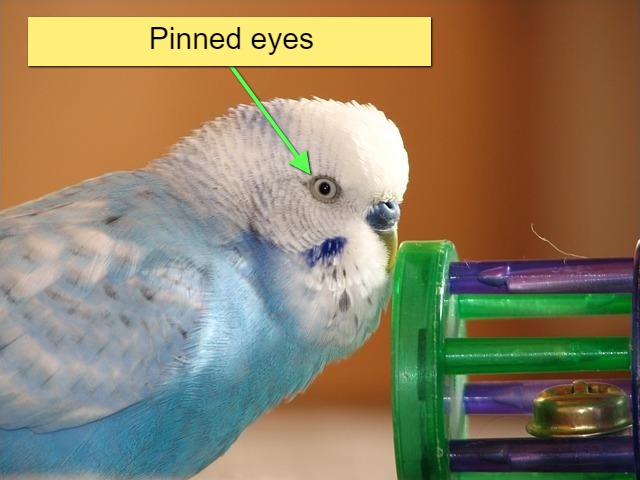
Stretching
The stretching movement in budgies is to accelerate the blood circulation in their bodies, keeping muscles flexible, strong, and healthy, and keeping the range of motion in the joints, as in many other species.
Showing an Attack Stance
Budgies show attack position just before attacking other budgies or other animals. Budgies keep their bodies close to the ground, opening their wings slightly and keeping their beaks half-opened and ready to bite.
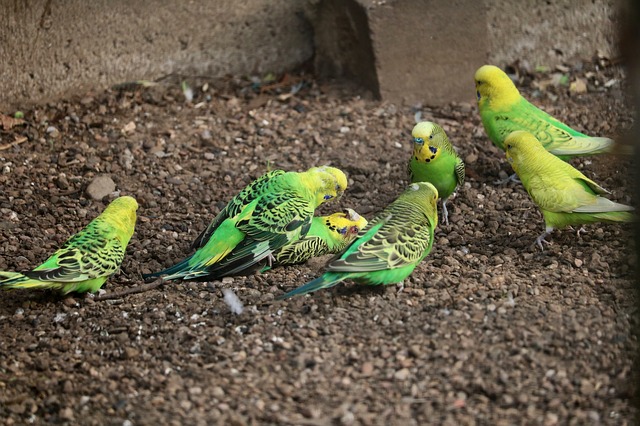
Preening (Grooming)
Preening is a routine that budgies do every day and more than once a day. The preening process is also an indication that they feel safe where they live. Budgies often preen themselves. However, they can also get help from other birds in the head and neck parts.
Budgies may also use objects such as cage wires and perches to preen their heads and necks.
Shivering
Budgies can shiver due to both environmental factors and mental and physical reasons such as cold, fear, sickness, and pain.
Biting
Budgerigars bite each other and other creatures for a variety of reasons.
The reasons why budgies tend to bite can be listed as follows:
- Communication
- Showing dominance
- Territorial protection
- Protecting the food
- Expressing the desire to mate
- Anger
- Fright
- Dissatisfaction
- Harming the opposing side in a fight
- Self-protecting
Opening and Closing Beak
Budgies make the beak opening and closing movement for more than one reason, such as something stuck in the throat, infection, trying to talk silently, sore and itchy throat, and excess mucus cleaning.
Beak Clicking
Beak clicking is a high-pitched sound that budgies produce with their beaks and use in situations such as threats, warnings, and territorial protection. Budgies make sounds when they feel unsafe and under attack.
Beak Grinding
Budgerigars often grind their beaks when they feel safe, at ease, and just before sleep.
Tail Flipping and Wagging
Tail fanning is interpreted in budgies as a sign of happiness.
Tail Fanning
Tail fanning is interpreted in budgies as a sign of aggression.
Cuddling
Since budgies are very social creatures, they want to be in constant physical contact with the creatures they bond with. That’s why cuddling is among the most common behavior of budgies with the creatures such as humans and other budgies they feel safe with.
How to Know My Budgie is Relaxed and Comfortable?
The behaviors that budgies do when they feel relaxed and comfortable can be listed as follows:
- Tail wagging
- Beak grinding
- Calmed head feathers
- Enlarged pupils of the eyes
- Chattering softly
How to Know My Budgie is Bored?
The signs that a budgie is bored can be listed as follows:
- Constantly changing places
- Constantly throwing and relocating objects
- Biting randomly
- Head bobbing
- Ear-piercing screams
- High-pitched squeaking
- Feather picking
- Hissing
- Dancing and body swinging
Hanging Upside Down
It is perfectly normal for budgies to hang upside down. Budgerigars can exhibit the act of standing upside down while eating, drinking water, playing games, and sleeping. Besides, this movement is also useful for hiding in the wild and for protection from birds of prey.
Regurgitating Food
Budgies usually exhibit the act of regurgitating food toward creatures and objects that they are very interested in.
In particular, male budgies deliver food by regurgitating to the females with this movement during the courtship and breeding season.
In addition, budgies regurgitate food on objects and creatures such as humans and toys they are interested in as a sign of affection.
Happy Budgie Body Language
The behavior of budgies, when they feel happy, can be listed as follows:
- Chirping
- Cuddling
- Beak grinding
- Chattering
- Whistling
- Playing
- Tail wagging
- Walking and hopping
- Head bobbing
- Good appetite
- Grooming
Aggressive Budgie Body Language
The behavior of budgies, when they are aggressive, can be listed as follows:
- Biting
- Chasing
- Sudden wing raising
- Hissing
- Picking feathers of the enemy
- Showing fully opened beak
Scared Budgie Body Language
The behavior of budgies, when they are scared, can be listed as follows:
- Wide open eyes
- Panting
- Making a watery poo
- Flat feathers
- Trying to fly fast in the cage
Affectionate and Friendly Budgie Body Language
The behaviors that show that the budgie is affectionate and friendly can be listed as follows:
- Talking to the owner and other creatures
- Cuddling with the owner and other creatures
- Whistling to the owner and other creatures
- Playing with the owner and other creatures
- Nibbling the owner and other creatures
- Flying over the owner and other creatures
- Tail wagging
- Walking and hopping around the owner and other creatures
- Head bobbing
New Budgie Body Language
When budgies are brought home for the first time, they behave differently than usual. They tend to behave differently and be self-protective whether there are other birds in their new environment or not.
The behavior of the new budgies can be listed as follows:
- Not eating
- Not drinking
- Not sleeping
- Wide open eyes
- Staying bottom of the cage
- Passing time in silence
Pregnant Budgie Body Language
When female budgies become pregnant, their behavior begins to change gradually. The pregnancy behavior of budgies can be listed as follows:
- Courting
- Moodiness
- Stressful movements
- Being more protective
- Starting to spend too much time around the nest
- Starting collecting materials for the nest
- Sitting in the nest
- Defending the nest
- Excessive interest, and affection in male budgies
Sick Budgie Body Language
There are some behaviors that sick budgies can exhibit, these behaviors can be listed as follows:
- Wing drooping
- Fluffed feathers
- Weak and unhealthy-looking feathers
- Not eating
- Not drinking
- Inactivity
- Weakness
- Not interacting or socializing
- Increase in sleep time
Hungry Budgie Body Language
The behavior of budgies, when they are hungry, can be listed as follows:
- Increased aggressive behavior
- Hissing and biting
- Unnecessary chasing of other budgies
- Starting to forage for food at the bottom of the cage
- Scratching the cage materials
- Starting to damage toys and materials with the beak
- Constantly screaming with more noise
- Head bobbing in baby budgies
REFERENCES
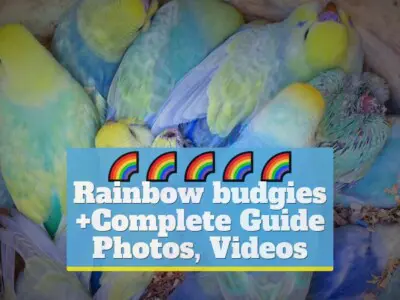
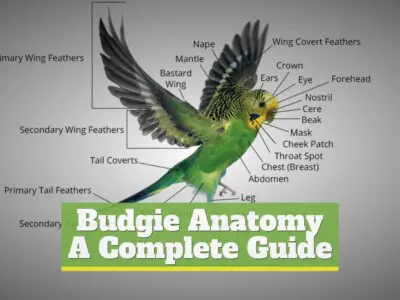
![Half-sider budgies [+WITH EXAMPLES PHOTOS & VIDEOS]](https://www.petiska.com/wp-content/uploads/2022/04/half-sider-budgies-with-examples-photos-videos-1649775303-400x300.jpg)
